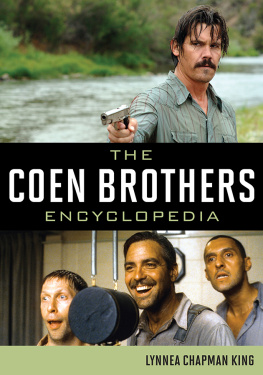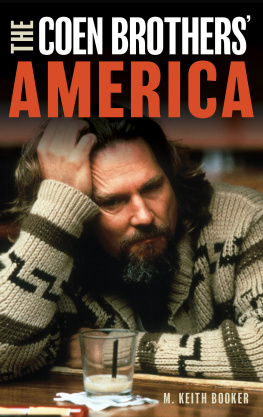
Contents
An Introduction
by Adam Nayman
In 2009, after seeing A Serious Man at the Toronto International Film Festival, I went to have coffee with a friend who had also been at the screening, and who had enjoyed the film considerably less than I did. What I saw as a riotously funny update of an Old Testament parablethe book of Job by way of The Twilight Zonewas for him a mean-spirited exercise in misanthropy. At one point, after nearly forty minutes of increasingly animated debate, he told me that my praise for the film was getting far too abstract; he said that the difference between us was that I was trying to look at the film in terms of the bigger picture. I laughed and said that I thought that the bigger picture was what A Serious Man was all about, suddenly feeling very much like the films protagonist, Larry Gopnik (Michael Stuhlbarg), standing meekly beneath a massive chalk scribblea proof so long and convoluted that it looks like an entire vast galaxy swirling above him.
The shot of Larry at the blackboard is, for me, the single most indelible frame in any movie by the Coen brothers. It is a microcosm of a cinema thats always gesturing toward the bigger picture. One of the occupational hazards that comes with writing about the work of Joel and Ethan Coen is that its easy to feel dwarfed by the sheer size, scope, and cosmological complexity of their cinematic universe. Its equally difficult to try to narrow your focus on any single movie hovering somewhere within it. No sooner have you started talking about one of their films than you start circling back to another, and then another, a daisy chain of associations held together by the certainty that, for all their focus on random mischance, nothing in the brothers vise-tight, magisterially engineered movies could possibly be happening by accident. This is true on a film by film basis, but also collectively; the moments of resemblance, resonance, and recognition across their filmography are many. Even the most apparently incidental detaila low-angle shot of a highway; a fleeting reflection in a television set; the name of a nightclub mentioned in passingcan be angled to connect in several directions at once, both within the shape of the film and beyond it, toward some Grand Unified Theory of Coen-ness.
For instance, the image of a Soviet submarine surfacing off the coast of California to receive a delegation of blacklisted Hollywood screenwriters in the 1950s-set Hail, Caesar! has a deliriously double-edged resonance. It nostalgically hyperbolizes Cold War era paranoia (the Russians are coming! The Russians are coming!) while also signifying strangely within a post-Trump zeitgeist (theyre already here!). But it also finds the Coens, in their sixteenth feature, calling back directly to the opening scene of their debuta monologue by the corrupt private detective Visser that kicks off the Texas-set neo-noir Blood Simple (1984).
The world is full of complainers. But the fact is, nothing comes with a guarantee. I don't care if youre the Pope of Rome, President of the United States, or even Man of the Yearsomething can always go wrong. And go ahead, complain, tell your problems to your neighbor, ask for helpwatch him fly. Now in Russia, they got it mapped out so that everyone pulls for everyone else-thats the theory, anyway. But what I know about is Texas... and down here... youre on your own.
The contrast between the U. S. of A. and the Evil Empire hinted at in Vissers voice-over plays out more fully in Hail, Caesar! Its a contrast manifested in the swank, Burbank backdrop of Capitol Pictures and the contents of Marxs Das Kapital, which has become the reading material of choice for a group of backlot dissidents. Their plan to kidnap the studios biggest star and send the ransom money to the motherland permits Hail, Caesar! to pivot on a perfectly circular conceptual gag, which is that the Hollywood Communists need Capitols capital in order to honor Das Kapital. But the joke also spins 180 degrees on its other axis: Hail, Caesar! is a film of uniquely vexed contradictions. When Capitols fixer, Eddie Mannix, retrieves the semi-brainwashed matinee idol Baird Whitlock and goes to slap the socialism right out of him, he ends up sounding suspiciously Soviet: The picture has worth, and if you have worth, you serve the picture! Is he describing the top-down mandate of assembly-line moviemaking, or the utopian possibilities of a system where everyone pulls for everyone else? Would that it twere so (blood) simple...
A diabolical comedy of ideas masquerading as old Hollywood pastiche, Hail, Caesar! is structured as an ideological feedback loop, and it encircles several of its predecessors in the process, including Barton Finkwhich was also set at Capitol Pictures, in the 1930s, and thus functions unofficially as a prequeland Burn After Reading, which unfolds in Washington long after the Cold War has thawed out into a lukewarm pool of leftover paranoia. You are not ideological? asks the Russian apparatchik incredulously of the civilians whove come to his office looking to sell what they think are state secrets. Placed as a question, its also a commentary on a willingness to undermine their countrys national security in exchange for financial gain (even as their greed confirms them as capitalists through and through). With its opening and closing Gods-eye-view shotsa wry reminder of the bigger pictureBurn After Reading also has a perfectly circular structure, and the stolen computer disc containing (worthless) CIA data that catalyzes its plot is an emblem of the characters hopelessly circuitous reasoning. Just as the quarter being flipped throughout No Country for Old Men by the contract killer Anton Chigurh is a symbol of the heartless profit motive he represents.
To move back and forth through the Coens career is to get caught in the loop, like riding a merry-go-round through a house of mirrors. A Venn diagram of their filmography would just be one big circle with smaller spheres orbiting it like planets. In addition to Burn After Readings burned CD and the fateful coin in No Country for Old Men, theres also the tumbling tumbleweed rolling through the opening credits of The Big Lebowski; the spherical set design of Americas Funniest Divorce Videos in Intolerable Cruelty; the sailing, dislodged hubcap that mutates and levitates into a UFO in The Man Who Wasnt There; and the whirling vortex that swallows the suburban universe of A Serious Man whole. The Hudsucker Proxy fully revolves around the Hula-Hoop dreamed up by the idiot-savant idea man Norville Barnes, which gets echoed in the rotating halo of the angel who flies to his rescue in the final scenea zero thats also infinite, circles within circles. The loop also rolls all the way back to Blood Simple, in the sequence where each of the characters making up the three points in the scripts tainted love triangle is glimpsed either sleeping or seething beneath ceiling fans, which just keep recirculating all that body heat sweltering between them.
It is a measure of the Coens meticulous M.O. that everyday objects become freighted with portent. These include ceiling fans and Hula-Hoops, but also asymmetrical items like hats, hatchets, briefcases, and typewriters. If these films frequently touch on the metaphysical, its via a tactile presentation that renders the material world with startling solidity and clarity. Like no director since Stanley Kubrickone of the few filmmakers whose shadow falls over Joel and Ethans playground, says the American critic and programmer Kent Jonesthey are obsessives who calibrate their frames and soundscapes down to the millimeter. The next visibly imprecise camera placement or sloppy dialogue cue in their work will also be the first.
Next page











